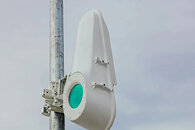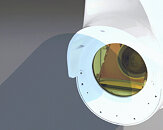Raevenlord
News Editor
- Joined
- Aug 12, 2016
- Messages
- 3,755 (1.21/day)
- Location
- Portugal
| System Name | The Ryzening |
|---|---|
| Processor | AMD Ryzen 9 5900X |
| Motherboard | MSI X570 MAG TOMAHAWK |
| Cooling | Lian Li Galahad 360mm AIO |
| Memory | 32 GB G.Skill Trident Z F4-3733 (4x 8 GB) |
| Video Card(s) | Gigabyte RTX 3070 Ti |
| Storage | Boot: Transcend MTE220S 2TB, Kintson A2000 1TB, Seagate Firewolf Pro 14 TB |
| Display(s) | Acer Nitro VG270UP (1440p 144 Hz IPS) |
| Case | Lian Li O11DX Dynamic White |
| Audio Device(s) | iFi Audio Zen DAC |
| Power Supply | Seasonic Focus+ 750 W |
| Mouse | Cooler Master Masterkeys Lite L |
| Keyboard | Cooler Master Masterkeys Lite L |
| Software | Windows 10 x64 |
Alphabet has announced that its prototype implementation of a laser-based communications system, Project Taara, successfully managed to transmit over 700 Terabytes of data over a 5 km distance. The system successfully transmitted the information across the Congo river in the African continent, connecting the towns of Brazzaville (Republic of Congo) and Kinshasa (Democratic Republic of Congo). The system aims to deliver fiber-optic-level communications speed in locations where infrastructure investment cost for a fiber optics solution is economically unfeasible. In this case, Project Taara delivered the high-speed connection where 250 miles of fiber network cabling would need to be laid out to achieve the same effect. It should also allow for cheaper infrastructure development in well-developed cities.
The project has taken the Free Space Optical Communications technology developed for Project Loon, one of Alphabet's explorations on delivering high-speed internet connections to rural areas whilst using stratospheric helium balloons. Alphabet said that its Project Taara link was operational for 20 days during the test period, where it achieved a signal availability level of 99.9% - meaning that it was practically uninterrupted. The laser system features self-adjustment capabilities that aim to circumvent weather and wildlife elements, which allow the lasers to not only boost the laser strength if required, but also to adjust the output and input laser dishes by up to +/- 5 degrees. The system's current development stage should allows for "a light beam the width of a chopstick accurately enough to hit a 5-centimeter target that's 10 kilometers away."


The project was first deployed for testing in India, and the team behind it shared the following video which sheds some light on the process.
View at TechPowerUp Main Site
The project has taken the Free Space Optical Communications technology developed for Project Loon, one of Alphabet's explorations on delivering high-speed internet connections to rural areas whilst using stratospheric helium balloons. Alphabet said that its Project Taara link was operational for 20 days during the test period, where it achieved a signal availability level of 99.9% - meaning that it was practically uninterrupted. The laser system features self-adjustment capabilities that aim to circumvent weather and wildlife elements, which allow the lasers to not only boost the laser strength if required, but also to adjust the output and input laser dishes by up to +/- 5 degrees. The system's current development stage should allows for "a light beam the width of a chopstick accurately enough to hit a 5-centimeter target that's 10 kilometers away."


The project was first deployed for testing in India, and the team behind it shared the following video which sheds some light on the process.
View at TechPowerUp Main Site








